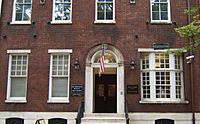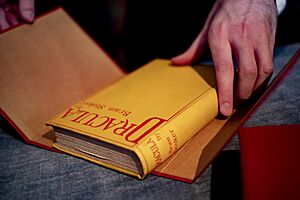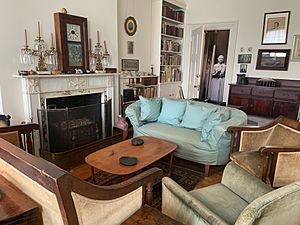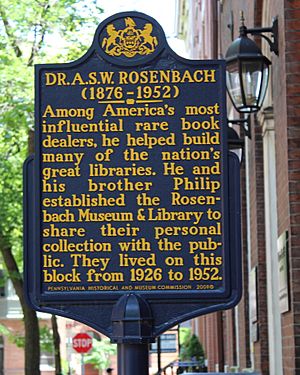Rosenbach Museum and Library facts for kids

The Rosenbach in 2009
|
|
| Established | 1954 |
|---|---|
| Location | 2008 and 2010 Delancey Place Delancey Place (Philadelphia), Philadelphia, Pennsylvania |
| Public transit access | |
The Rosenbach is a special museum and library in Philadelphia. It's located inside two old houses from the 1800s. It was started in 1954 thanks to a gift from two brothers, Dr. Abraham Simon Wolf Rosenbach and Philip H. Rosenbach. These houses hold their amazing collections.
The Rosenbach offers fun programs like tours, classes, and book clubs. They even have a free online show called Biblioventures. It's also the home of Bloomsday in Philadelphia. This is a yearly festival on June 16 that celebrates James Joyce's famous book, Ulysses.
The brothers owned a company called the Rosenbach Company. They were important dealers of rare books, old manuscripts, and beautiful art. Dr. Rosenbach especially helped build many big libraries. These include the Widener Library at Harvard and the Folger Shakespeare Library. Since 2013, the Rosenbach has been part of the Free Library of Philadelphia Foundation. However, it still has its own board and runs its own programs.
Contents
Exploring America's Past: Rare Books and Manuscripts
The Rosenbach has a fantastic collection about early America. It starts with stories of early voyages and explorations.
Early Journeys and Discoveries
- You can find a copy of Antonio Pigafetta's story about Ferdinand Magellan's trip around the world.
- There are also rare papers about the first settlements in Virginia.
- The collection includes letters from famous explorers like Cortés, Pizarro, and de Soto.
- One letter from Cortés in 1532 asks for permission to explore the coast of California.
Colonial Life and Early Books
The museum has many items from the time of colonial settlement. These include early accounts and important religious writings. There are also stories about Native Americans and a collection of "Indian Captivity Tales."
The Rosenbach also owns some of the very first books printed in the Western Hemisphere. These include books from Mexico (1543–44) and Lima (1584–85). It also has the famous Bay Psalm Book. This was the first book printed in what is now the United States, in Cambridge, Massachusetts (1661).
The American Revolution and Beyond
The American Revolution is well-documented here.
- There are over 100 letters written by George Washington.
- You can see the original paper from the Continental Congress that started the Revolution.
- There's a great collection of documents signed by those who signed the Declaration of Independence.
- You can also find Franklin's Poor Richard's Almanacks. This includes the only known copy of the very first edition from 1733.
Westward Expansion and the Civil War
The collection also covers the time of westward expansion. It has early diaries and travel stories. There are also printed guides and histories. Items about the Pacific Northwest are very important. These include diaries from Oregon pioneers. There's even a document signed by Andrew Johnson allowing Seward to buy Alaska.
The material from the Civil War is very large.
- It has over 200 letters from Abraham Lincoln.
- There are 150 war letters from Ulysses S. Grant.
- You can see two letters from Robert E. Lee.
- The original paper signed by both parts of the United States Congress is also here. This paper proposed the Thirteenth Amendment, which ended slavery.
Amazing Literature: Irish, British, and American Works
This collection starts with beautiful English writings from the 1400s.
Early English Literature
- It includes poems by Thomas Hoccleve (1410) with a famous picture of Chaucer.
- There's a major handwritten copy of the Canterbury Tales.
- You can also see a very rare first edition of Pilgrim's Progress.
18th and 19th Century Authors
Most major British writers from the 1700s are here. You can find first editions of their important books. Many also have handwritten papers.
- Highlights include Tonson's copy of Milton's Paradise Lost.
- There are letters from Thomas Gray.
- You can see parts of the handwritten Life of Johnson by James Boswell.
- The Rosenbach has the largest collection of Robert Burns handwritten papers anywhere.
The collection gets even stronger as you move into the 1800s and 1900s.
- There are handwritten works by Walter Scott, William Wordsworth, and Charles Lamb.
- You can also find papers from Shelley and Keats. This includes a famous love letter to Fanny Brawne.
- The only remaining part of Fitzgerald's Rubaiyat of Omar Khayyam is here.
Dickens, Carroll, and More
The Rosenbach has a fantastic Dickens collection. It goes from his earliest known handwritten work to a photo signed the day before he died. The collection also includes Dickens' handwritten copies of Nicholas Nickleby and the Pickwick Papers.
Lewis Carroll is represented by over 600 letters. There are also early drawings, special books, and photos. His own first-edition copy of Alice in Wonderland is here too. Other handwritten works include those by Oscar Wilde, Aubrey Beardsley, Arthur Conan Doyle, Joseph Conrad, and Dylan Thomas.
James Joyce and Marianne Moore
One of the museum's most valuable items is the handwritten manuscript of James Joyce's Ulysses. To celebrate this book, the museum hosts a Bloomsday event every year. This includes readings from parts of the book.
The Rosenbach also has a recreation of Marianne Moore's living room. It looks just as it did when she lived and worked there for over 40 years. Moore's complete library is part of the collection. Many of her books have personal notes from friends like Ezra Pound, T.S. Eliot, and Elizabeth Bishop. All her letters and drafts of her poems are also kept here.
Amazing Book Illustrations
The museum has a wonderful collection of book illustrations. It includes many beautiful medieval drawings. There are also drawings by great French artists from the 1700s. These include François Boucher, Jean-Honoré Fragonard, and Hubert Gravelot.
- An important group of drawings, watercolors, and books by William Blake.
- Drawings to illustrate Don Quixote by Honoré Daumier and Salvador Dali.
- Drawings by Thomas Rowlandson and George Cruikshank.
- Sketches by William Makepeace Thackeray for his own books.
- John Tenniel's drawings for Alice and Through the Looking Glass.
- Works by Aubrey Beardsley and Ernest Shepard.
Beautiful Decorative Arts Collections
Most of the house is set up just as the Rosenbach brothers lived in it. The furniture is mainly English from the 1700s. There are great examples by famous makers like Chippendale and Sheraton.
Other important pieces include an olivewood box made for Charles II. There's also a major Philadelphia highboy. The museum has a large collection of English silver and gold from the 1600s and mid-1700s. This includes amazing works by Paul Storr and Hester Bateman. There are also special items made for the British royal family.
Over 1,000 small portrait miniatures are in the collection. This includes one by Nicholas Hilliard of James I. Beautiful collections of 1700s porcelain, glass, paintings, drawings, and sculptures complete the furnishings.
The building next door, at 2008 Delancey Place, was bought in 1993. This allowed the museum to grow and have more space for exhibits.
Honoring Dr. A.S.W. Rosenbach
On April 2, 2008, the Rosenbach received a special State Historical Marker. The Pennsylvania Historical and Museum Commission gave it to honor Dr. A.S.W. Rosenbach. He was a co-founder of the museum. The marker celebrates his legacy as one of America's greatest rare book dealers. It also recognizes his lasting contributions to Philadelphia. The sign is in front of the museum at 2008-2010 Delancey Place. It is in the historic Rittenhouse Square neighborhood.
The sign reads:
"Dr. A.S.W. Rosenbach (1876–1952) Among America's most influential rare book dealers, he helped build many of the nation's great libraries. He and his brother Philip established the Rosenbach to share their personal collection with the public. They lived on this block from 1926 to 1952."
The Maurice Sendak Collection
Famous author and illustrator Maurice Sendak chose the Rosenbach to keep his work. This was from 1968 to 2014. He chose it because they shared interests in books and collecting. His personal works were returned to his estate in 2014. They are now cared for by the Sendak Foundation.
The Rosenbach is home to Sendak's rare book collection. This includes rare books by Herman Melville, Beatrix Potter, and William Blake. It also has pop-up books by Lothar Meggendorfer. Sendak is the author and illustrator of Where the Wild Things Are and 108 other books. His collection has nearly 10,000 works of art, handwritten papers, books, and other items. It has been shown in many exhibits at the Rosenbach. Visitors of all ages have enjoyed it.




